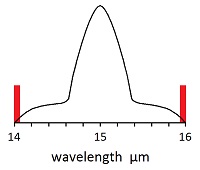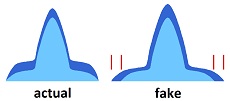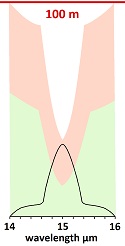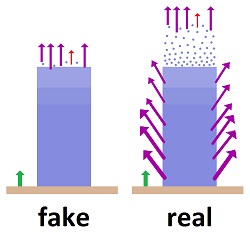|
| Gary Novak
The Cause of Ice Ages and Present Climate |
There is an unsolvable problem at the starting point of global warming claims: There is no mechanism for carbon dioxide creating global warming.
Even if greenhouse gases created some global warming, they long ago did all they can do. They absorbed all radiation available to them, so more of such gases cannot absorb more radiation. This effect is called saturation. Nonscientists who promote global warming assume that the mechanism for creating global warming from greenhouse gases is so simple that you would have to be irrational to not believe that it is occurring. Scientists cannot describe a mechanism, because they cannot explain away saturation. Numerous mechanisms have been claimed, but they are all absurdly in contradiction to numerous elements of the science.
The red lines on this image at 14 and 16 microns wavelength show where the effect supposedly would occur. This mechanism did not stand up to criticism and was largely abandoned for two major reasons. One, the shoulder molecules still saturate, even when looking at one thousandth of the curve. The center of the curve saturates in 10 meters. That means all radiation gets used up by the time it travels 10 meters (at ground level). At one thousandth that amount, saturation occurs in 10 kilometers, which is less than the distance to the top of the normal atmosphere (troposphere), which is about 15 km (7-20 km). (The shoulder molecules are in slightly different energy states due to stretching of bonds, as if they were different molecules. The 5% shoulders have twenty times as much space between each, because there are one twentieth as many of them.) The second absurdity of shoulder molecules creating global warming is that the CO2 molecules involved are so extremely thin that they could not be relevant. The total CO2 is 400 parts per million of the atmosphere. If the relevant shoulders are one thousandth, they are 400 parts per billion of the atmosphere. That means there are 2.5 million air molecules around each of the shoulder molecules which supposedly do the heating. To cause 1°C temperature increase in the atmosphere, the CO2 molecules of concern would need to be transferring 2.5 million times as much heat, which would be the equivalent of 2.5 million degrees centigrade, which is of course absurd. Yet as late as 2001, the IPCC report was stating that the shoulder molecules on the absorption spectrum were doing the heating (IPCC (AR3)), as indicated by this quote:
Heinz Hug indicated the shoulder effect was being claimed in the IPCC report of 1990 (before IPCC reports were on the internet) citing this quote: "The effect of added carbon dioxide molecules is, however, significant at the edges of the 15 µm band, and in particular around 13.7 and 16 µm" (Climate Change 1990. The IPCC Scientific Assessment, p. 49). This means the shoulder effect was claimed to be the mechanism up to at least 2001, while Heinz Hug showed that the claims were absurd, as the logic described above shows. A few years ago, it was common to see on the internet the claim that 5% of the absorption spectrum was non-saturated for creating global warming. This would mean that saturation occurs in 20 times the distance of the center of the peak, which is 20 times 10 meters, or 200 meters. Such a short distance would do nothing, as convectional currents stir such air, and changing the distance is not an increase in temperature. Quantities are also absurd with the 5% claim. Shoulder molecules would do one twentieth as much as the peak molecules, and they would produce one twentieth as much temperature effect for the same amount of heat, since they are spread over twenty times as much atmosphere. This means 20 times 20, or 400, times as much temperature effect at the peak as on the shoulders. If the shoulders increased the near surface temperature of the atmosphere by 1°C, the peak would have increased the temperature by 400°C, which would have occurred prior to saturation. Of course, nothing in the atmosphere can create a 400°C temperature increase.
Bandwidth gets narrower higher in the atmosphere, because lower pressure does change the energy state slightly. But pressure does not change due to increases in greenhouse gases, since they are only a few parts per million concentration. The false assumption of bandwidth widening is often rationalized with a World War II graph of absorption taken high in the atmosphere from a propeller airplane. It shows nothing but engine noise consisting of sine waves. Absorption spectra are never sine waves, they are always bell curves. The Stefan-Boltzmann Constant Applied to the Atmosphere For some reason, there has been much talk of the Stefan-Boltzmann constant (SBC) determining where global warming occurs. The SBC says how much radiation is given off by solids at any given temperature. It is not appropriate for gases, yet it is applied to the atmosphere. Gases will emit radiation much more readily than solids, because radiation can leave throughout a transparent gas, while it is blocked by all molecules except a thin layer near the surface for opaque solids. The claim was made that radiation which cools the planet must leave at a height of 5 km up in the atmosphere, because the SBC says the same amount of radiation will leave at -19°C as entering from the sun, which is 235 watts per square meter. If the radiation leaves at 5 km, what keeps it from leaving at other heights, such as 4 km or 6 km. Nothing could. This shows the absurdity of applying the SBC to a transparent gas.
The usual claim is that the heating occurs at a height of 9 km up in the atmosphere. Shifting the explanation to high in the atmosphere creates additional absurdities. The first problem is that there is no way to get high enough in the atmosphere to get around saturation. Climatologists picked 9 km up as a means of staying within the troposphere. At that height, the atmospheric density is 30% of that at sea level. This means distances increase by a factor of 3.3 for absorption of radiation. Changing the distances is not increasing the heat. Another problem with the upper atmosphere is the temperature would have to increase 24°C to radiate enough energy back to increase the temperature of the near-surface atmosphere by 1°C. No temperature increase due to CO2 has been detected in the upper atmosphere. The basis for 24°C is this: (Assuming a mass of air at 9 km height must heat an equal mass of air near the surface of the earth by radiating energy downward.) According to the Stefan-Boltzmann constant, matter at a temperature of About 30% of radiation would be reflected at sharp angles, which means the temperature increase at 9 km must be divided by 0.70. The result is (2 x 3.3 x 2.5) ÷ 0.70 = 24°C. Oceans Would Absorb most of the back-radiation: Actually, the problem is much worse than this, because back radiation cannot heat an equal mass of air, it must be absorbed by the surface of the earth or oceans. The oceans would absorb immense amounts of back radiation. The ocean temperature must be increased by 1°C before the air over it will increase by 1°C. To back-radiate that much heat would require a huge temperature increase in the supposed zone in the upper atmosphere. Equilibrium Added to the Upper Atmosphere Concept A recent way the logic of this mechanism up high is being described is to claim that saturation is not occurring up high (which is ridiculous) and that the lower atmosphere must heat up to cause the upper atmosphere to heat up enough to emit the right amount of radiation to establish equilibrium with the amount coming from the sun. Back radiation is being omitted from this explanation, since it would not stand up to criticism. But as usual, the fix goes from bad to worse. Nothing near the surface is going to change because of a need for heat up high in the atmosphere. If such a thing were occurring, the heat would develop up high where the blocking was occurring, while nothing would change near the surface. Also, the molecules which supposedly do the heating without saturating would be about one thousandth the concentration of the center of the absorption peak, which are 400 parts per million, which would be 400 parts per billion. That means about 2.5 million air molecules around each CO2 molecules which does the heating. This would be 10 km up, which is 1000 times the 10 meters for saturation at the center of the peak. One molecule in several million absorbing finger print radiation, which is extremely weak, is no heat at all. It's the amount of heat originally created by the rest of the CO2 divided by 2.5 million.
In other words, even if the mechanisms existed as rationalizers claim, the quantities would be so trivial that there would not be the slightest relevance to the claimed results. A fake mathematical result is claimed (through radiative transfer equations), but it contradicts obvious logic in extreme ways.
The lower temperature with height in the atmosphere would be due to radiation escaping from all points in the atmosphere and going into space, as shown by this image: The reason why a fake adiabatic effect was needed was to pretend that there is nothing cooling the atmosphere but radiation escaping from the top. Otherwise, heating from down low would not be the determining factor for heating at the top where the magic of global warming was occurring. The direct link between heating at the bottom and heating at the top is the explanation used for getting heat from the top to the bottom due to global warming by CO2. If that link is broken, there is no way to get the effect up high to cause heating near the surface. The atmosphere is cooled by radiation which goes around greenhouse gases, which means greenhouse gases are irrelevant. |
||||||||||||||||



 is not uncommon to see the absurd claim that the bandwidth widens when the amount of CO2 increases in the atmosphere, and this allows more absorption. No change in bandwidth is possible with increases in CO2, because bandwidth is determined by the energy sate of molecules. Energy state does not change as concentration changes.
is not uncommon to see the absurd claim that the bandwidth widens when the amount of CO2 increases in the atmosphere, and this allows more absorption. No change in bandwidth is possible with increases in CO2, because bandwidth is determined by the energy sate of molecules. Energy state does not change as concentration changes. Since half of the radiation would go upward and half downward, the required temperature must be increased by a factor of 2. Since 30% of infrared radiation goes around greenhouse gases, the temperature must be increased by a factor of 3.3. Sometimes a range is given as 15-30% for radiation going around greenhouse gases. If it's 15%, the temperature increase high in the atmosphere must be 48°C rather than
Since half of the radiation would go upward and half downward, the required temperature must be increased by a factor of 2. Since 30% of infrared radiation goes around greenhouse gases, the temperature must be increased by a factor of 3.3. Sometimes a range is given as 15-30% for radiation going around greenhouse gases. If it's 15%, the temperature increase high in the atmosphere must be 48°C rather than  If for example, CO2 added 10°C to the atmosphere originally, as some claim, dividing by 2.5 million would be 0.000004°C at 10 km up. But even this amount would be reduced greatly, because the atmosphere is not the same pressure up high. Lower the pressure by one tenth, and the temperature change would be reduced a lot more when absorbing radiation.
If for example, CO2 added 10°C to the atmosphere originally, as some claim, dividing by 2.5 million would be 0.000004°C at 10 km up. But even this amount would be reduced greatly, because the atmosphere is not the same pressure up high. Lower the pressure by one tenth, and the temperature change would be reduced a lot more when absorbing radiation.
 Most radiation leaves from the atmosphere, not the surface. These circles show how radiation is emitted within the atmosphere. What then is meant by saturation not occurring up high? It would mean that the circles get very large due to thin atmosphere, and more CO2 makes the circles smaller. Smaller supposedly means less radiation escapes into space. But there is only a one tenth reduction in air pressure at the top of the normal atmosphere (troposphere) which is 12-15 km up. One tenth is not enough difference to overcome the effects of saturation, when it occurs in 10 meters at sea-level pressure.
Most radiation leaves from the atmosphere, not the surface. These circles show how radiation is emitted within the atmosphere. What then is meant by saturation not occurring up high? It would mean that the circles get very large due to thin atmosphere, and more CO2 makes the circles smaller. Smaller supposedly means less radiation escapes into space. But there is only a one tenth reduction in air pressure at the top of the normal atmosphere (troposphere) which is 12-15 km up. One tenth is not enough difference to overcome the effects of saturation, when it occurs in 10 meters at sea-level pressure.